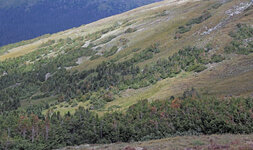The problem with experience comes when you have the wrong kind.
Most hunters calibrate to what they have the most experience with, and it's not big bucks. It's "mule deer".
Think of mule deer in tiers - your lowest tier are yearlings and does, who may or may not see your movement at 1.5 miles for various reasons, between how they bed and the level of attention they pay. If they do see you at that distance they likely won't care much. They're not pressured or hunted by humans much. They'll wait until the danger is much closer, usually.
Your next tier are 2-3yo bucks. They'll both see you before the lower tier muleys, and will move out earlier, but they'll wait until you get closer - because they haven't experienced being hunted by humans much, but they're had a season or two to learn. But between wind, sound, and your movement, they've made you long, long before you have them, most of the time - but they just can't quite be bothered to move much yet. But some have learned to move before you get into common rifle range.
These first two tiers are the vast majority of what mule deer hunters are calibrated to - and it's the wrong kind of experience if you're looking for something older or bigger. You just cannot get away with the same mistakes the younger deer teach you are acceptable.
The top tier are your bucks that hit 4 years old or better - it's almost like a different kind of animal. The difference between a 4 or 5yo mule deer buck, and a 2yo, is almost like the difference between a yard goat and a pronghorn. Not only do they pay far more attention to their senses - including positioning themselves in the landscape to maximize their ability to do so - they take no chances and move out as soon as they detect you. To give you an idea of what level they're at, a big old buck beds down with at least 2-3 exact escape routes they know they'll take, depending on where danger comes in from, and they know exactly where they're going - backup bed. And it will be almost as secure as primary bed.
This is why almost nobody is calibrated to them - they're gone before you even knew they were there, on top of being far less common to begin with.
As a general rule with few exceptions, if you want to nail an old buck you'll need to do whatever it takes stay out of sight, out of sound, and out of smell, until you're ready to shoot.

